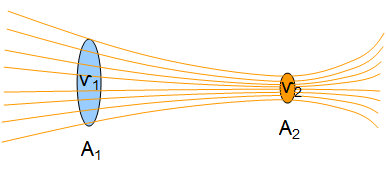Plating thickness uniformity can become increasingly difficult to control when migrating from four inch to six inch wafers, especially when plating through-wafer vias with non-cyanide gold bath solution. The standard tooling provided on our four inch plating equipment did not scale adequately for the larger wafer size and still maintain good process control. The solution implemented at Skyworks changes the plating solution delivery to the wafer surface to provide better process control and better plating uniformity. This process qualification was part of a Six Sigma team effort to help ensure timely project success.
When electroplating through-wafer vias (TWVs) on a Semitool Equinox® plating tool, the negative terminal of the power supply is connected to the wafer to make it the cathode and the positive terminal is connected to a metal disk parallel to the wafer to make it the anode. Gold plating uniformity is determined by the electrical contact made at the wafer perimeter, the electrical field from the anode disk parallel to the wafer, and the availability of gold ions when the wafer and anode are submerged in the plating bath solution. Our four inch wafer plating anode is attached at the top of an anode post (See Fig 1a).
Before plating starts the wafer is lowered into the plating solution, parallel to the anode, and it begins to rotate. When the plating current is initiated, gold ions are consumed from the plating solution, and additional solution from a plating tank is supplied through holes in the anode post under the anode. As our 4” plating bath aged, the conducting salt concentration increased and the center of the four inch wafer did not plate fully at the bottom of the vias. At higher conducting salt concentrations, the bath density increases and the larger, heavier gold ions cannot flow as freely into the vias. Since the wafer rotates during plating, plating solution is pulled away from the center due to centrifugal force. By drilling a hole in the center of the anode and the anode post more fresh plating solution is delivered to the center of the wafer (see Fig 1b). This solution delayed the onset of thinner plating in vias at the center of the wafer as the bath aged and allowed us to extend our plating bath life. Our challenge was to find a way to maintain the plating thickness uniformity as we increased our wafer size from four inch wafers to six inch wafers.
In addition to plating chemistry and bath flow rate, the wafer-to-anode separation distance plays a very important role in maintaining plating uniformity. If the wafer is too far away from the anode, the electric field between the wafer and anode is non-uniform and plating is thicker at the edge of the wafer than the center. The sheet resistance profile plots the inverse of the thickness as a convex pattern. As the wafer is moved closer to the anode, this profile flattens. If the wafer is moved too close to the anode the resistance profile becomes concave due to thicker plating at the wafer center and thinner plating at the edge. We use a four point resistance measurement at 225 sites on a 6 inch test wafer. The relatively large number of sites allows us to plot a three dimensional resistance profile with sufficient resolution to see small differences in anode designs. It is possible to use a simple algorithm to optimize the backside plating uniformity: a technician enters the plating head position, the sheet resistance percent uniformity, and the resistance profile shape (concave or convex) and a spreadsheet calculation provides the head adjustment required to optimize the plating uniformity. Since the plating profile is radial, the number of measurement sites can be reduced by measuring only along the diameter of the wafer.

Fig1
Above a via opening during plating, gold metal ions are transported into the via. As the gold ions are removed from the plating solution they leave behind a thin volume of plating solution with fewer gold ions next to the via wall. New gold ions must be transported into this region and diffuse through the boundary layer to allow plating to continue. If the layer is thick, it takes time for new ions to diffuse through this barrier and the plating rate will be reduced. Since the wafer rotates the boundary layer is likely to be thinned on the backside by the centrifugal force causing solution flow. However with the conventional anode, there is little to no agitation inside the vias to reduce this layer. The showerhead spray reduces the boundary layer inside the vias by spraying plating solution with a high flow rate perpendicular to the wafer surface several times a second.
下一篇: 化学镀金工艺优化